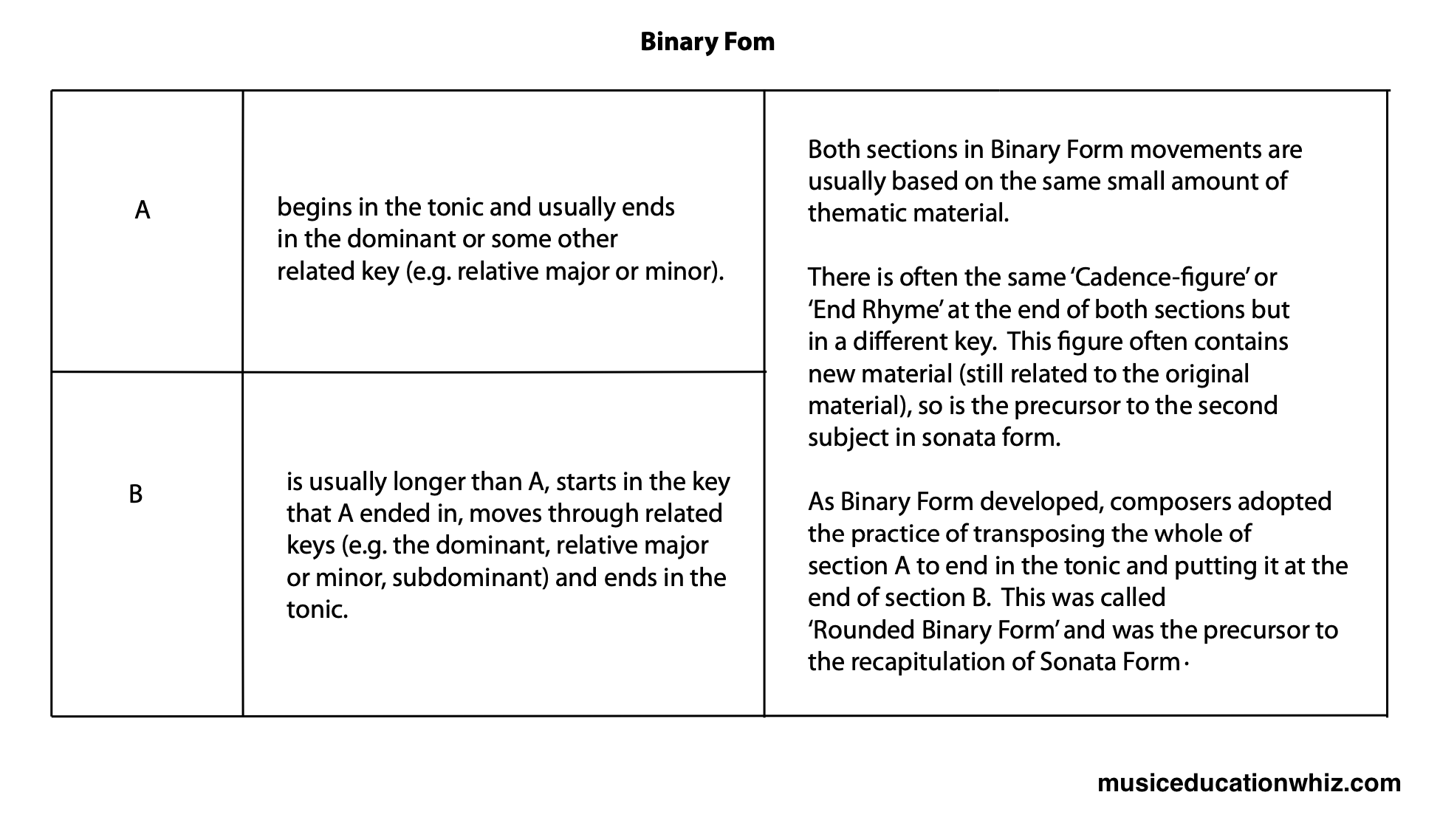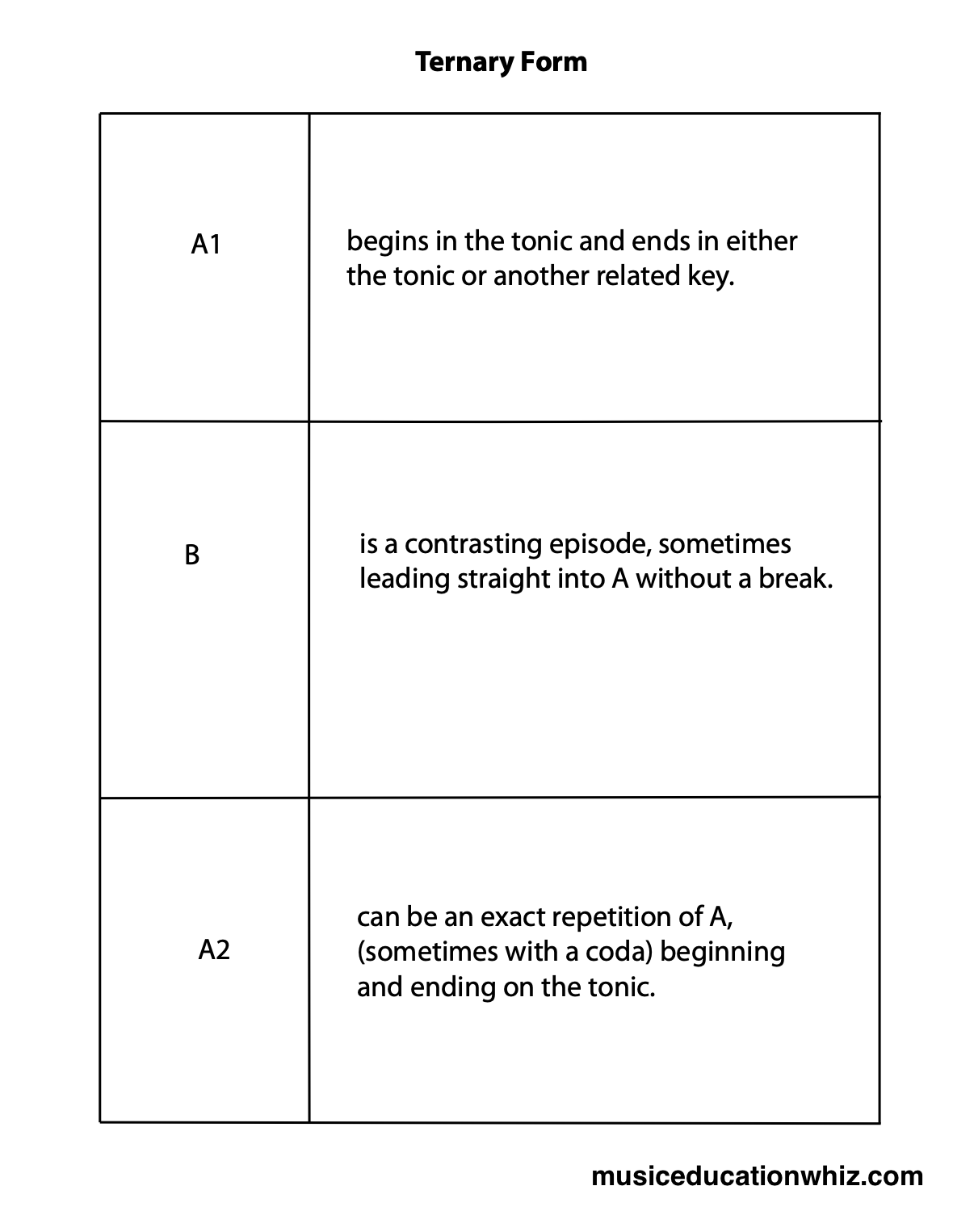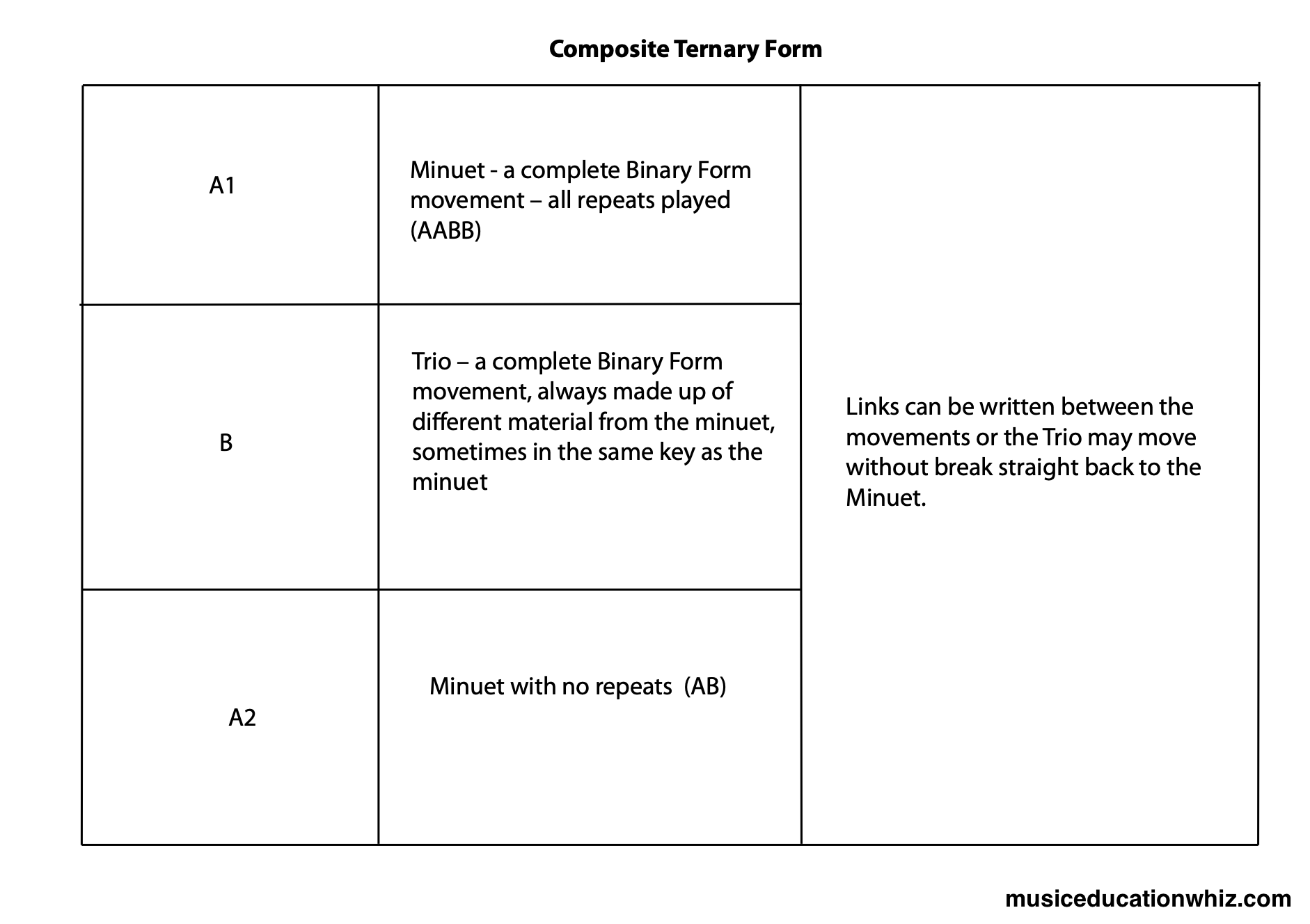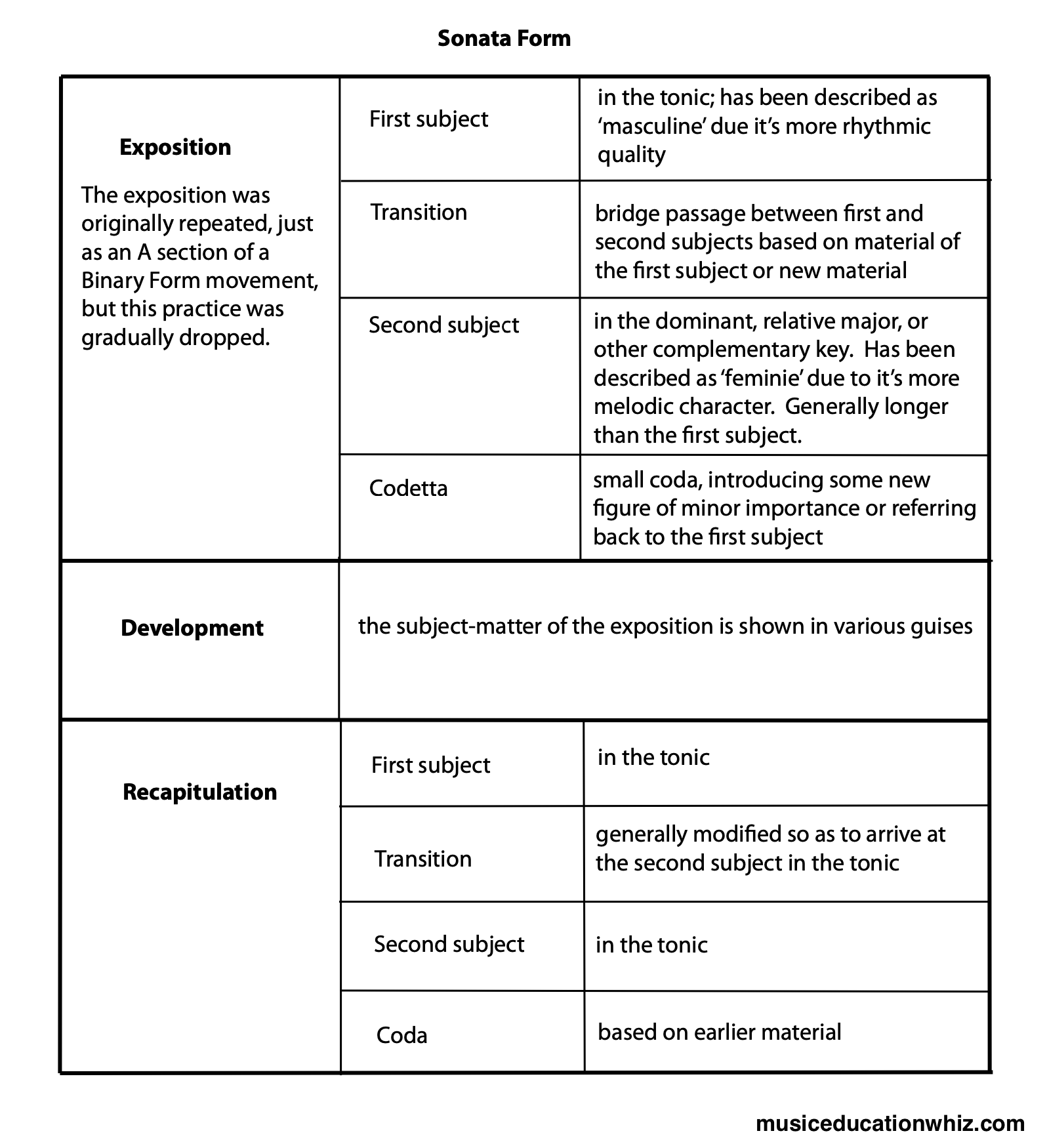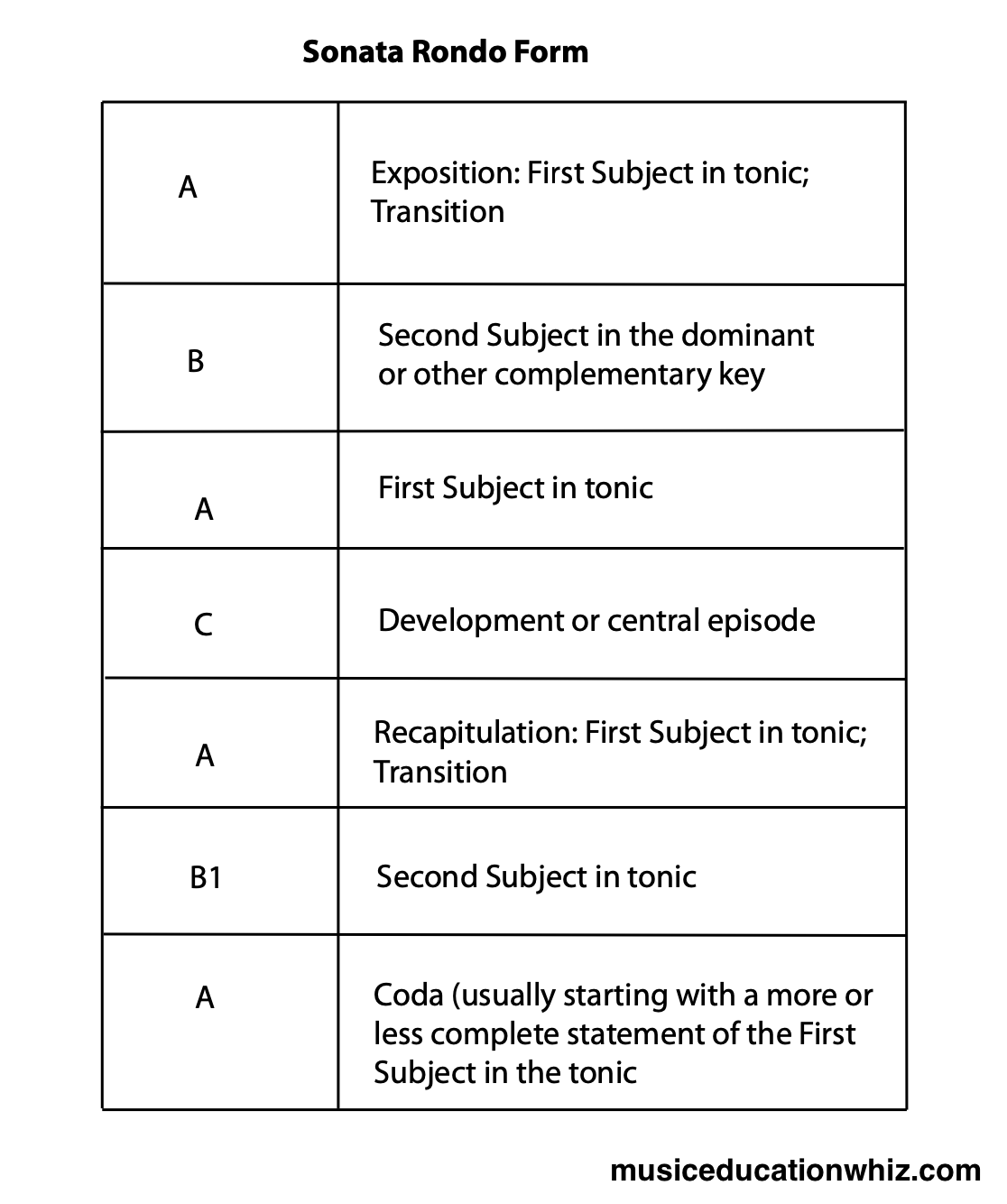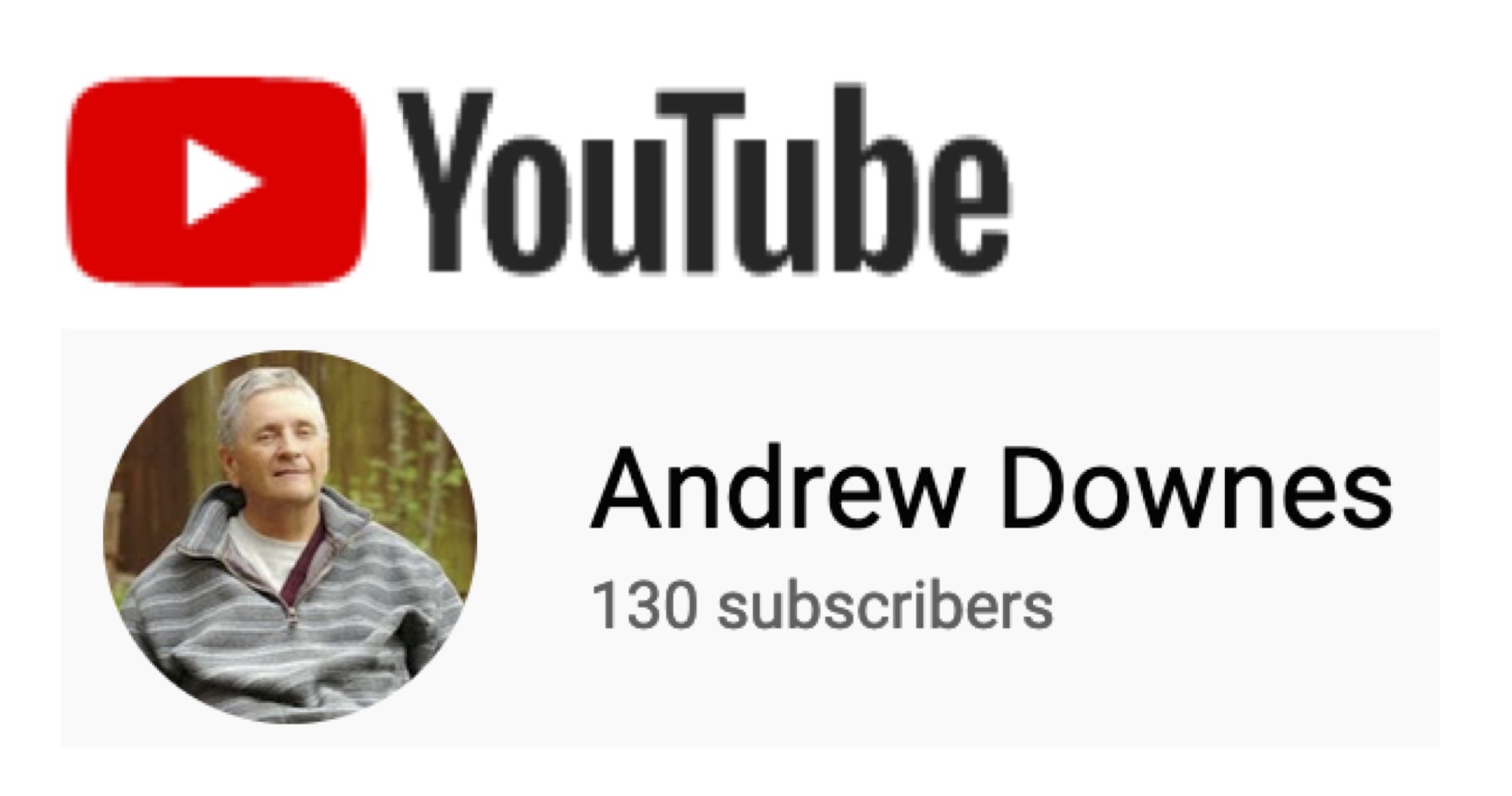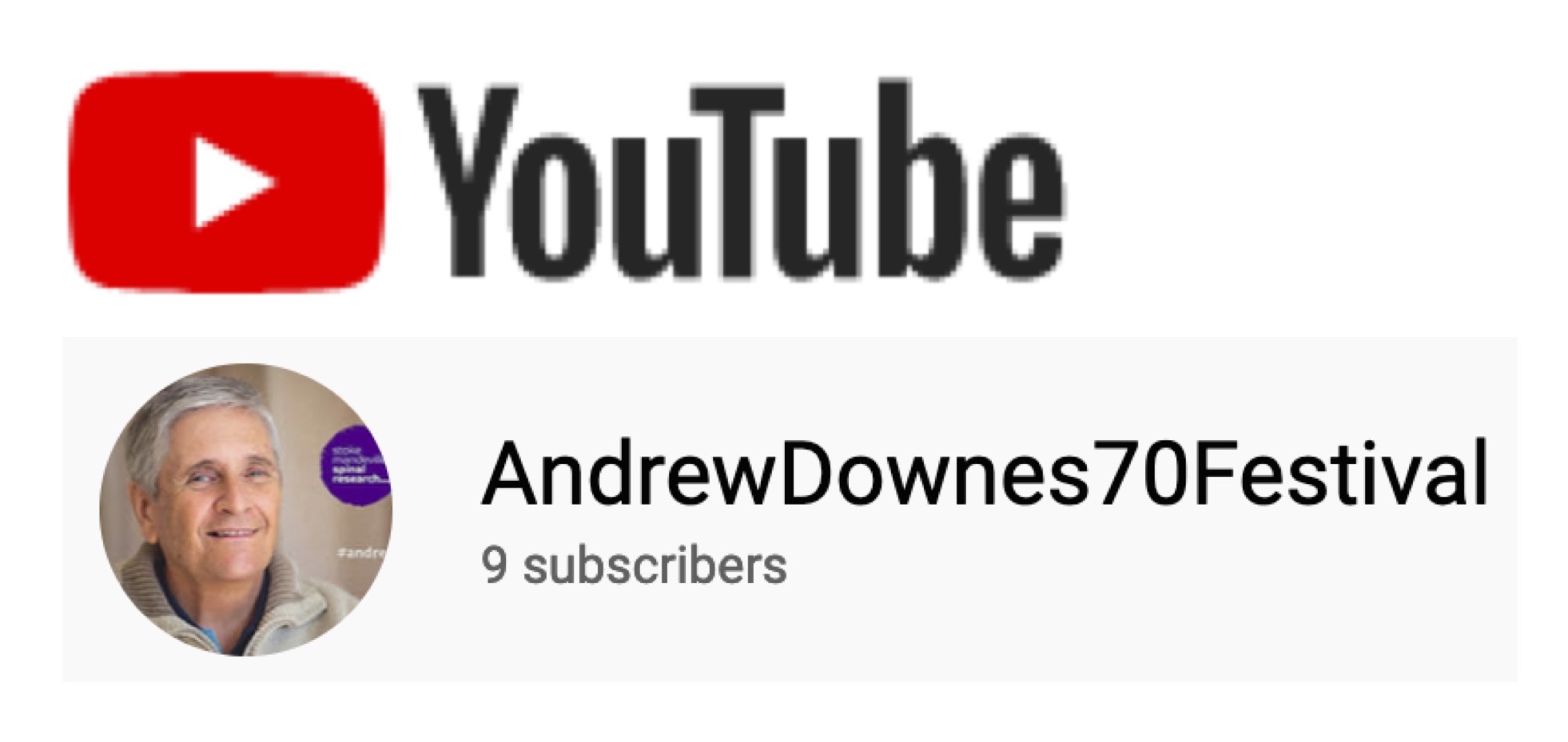Back to andrewdownes.com

Music Education
Resources by Paula Downes, a lot of music by Andrew Downes
Form or Structure in music
Musical Structure is clearly described and illustrated on this page with tables and videos. It is important to note that few pieces fit into form descriptions exactly as will be seen in some of the analyses on the videos.
If you wish to read about this topic in more detail, William Lovelock: Form In BriefClick to download pdfs of the analysed scores used in the videos below
On this page:
Phrases
Binary Form
Ternary Form
Composite Ternary Form
Da Capo Arias
Rondo Form
Ritornello Form
Sonata Form
Sonata Rondo Form
Fugue
Theme and Variations
Ground Bass
Phrases
Music is built out of phrases and sentences, in
the same way as speech and writing is.
A cadence is the ‘punctuation’ of a musical phrase. Phrases can be indicated in the music with phrase marks:
Different eras in music produced different sorts of phrases. In the classical era, periodic phrasing consisted of beautifully balanced antecedent and consequent phrases. An antecedent phrase is a question phrase, often ending on the dominant and therefore sounding incomplete. A consequent phrase is an answer phrase, often ending on the tonic and therefore sounding complete. Baa Baa Black Sheep is a good example of periodic phrase structure:
Download the pdf of the analysed score used in this video.
Sometimes though, the antecedent can end on the tonic and can be followed by a modulating consequent:
Download the pdf of the analysed score used in this video.
Phrases before and after the classical period were longer or shorter and less perfectly balanced:
Download the pdf of the analysed score used in this video.
Binary form
AB or AABB or ABAB
The 'Hornpipe' from Handel's Water Music is in Binary Form with End Rhyme:
Download the pdf of the analysed score used in this video.
The 'Air from Handel's Water Music is in Rounded Binary Form:
AABABA
Download the pdf of the analysed score used in this video.
Ternary From
ABA
Ternary Form is different from Binary form in that B is a contrasting ‘episode’
with either different material or key.
Some people believe ternary form needs to have contrasting material in
the episode, while others disagree.
Watch the video below to see this structure in an analysis of Chopin's Nocturne in G Minor:
Download the pdf of the analysed score used in this video.
Composite ternary form (also known as Extended
Ternary)
This structure can be found in the Minuet and Trio movements of Classical String Quartets
or Symphonies.
Watch the video below to see an analysis of the Minuet and Trio from Mozart's Eine Kleine Nachtmusik:
Download the pdf of the analysed score used in this video.
Da Capo arias
ABA
These are ternary form pieces for voice, which developed in the Baroque
era. Numerous examples can be found in
Handel’s operas and oratorios. They are
also usually in ritornello form.
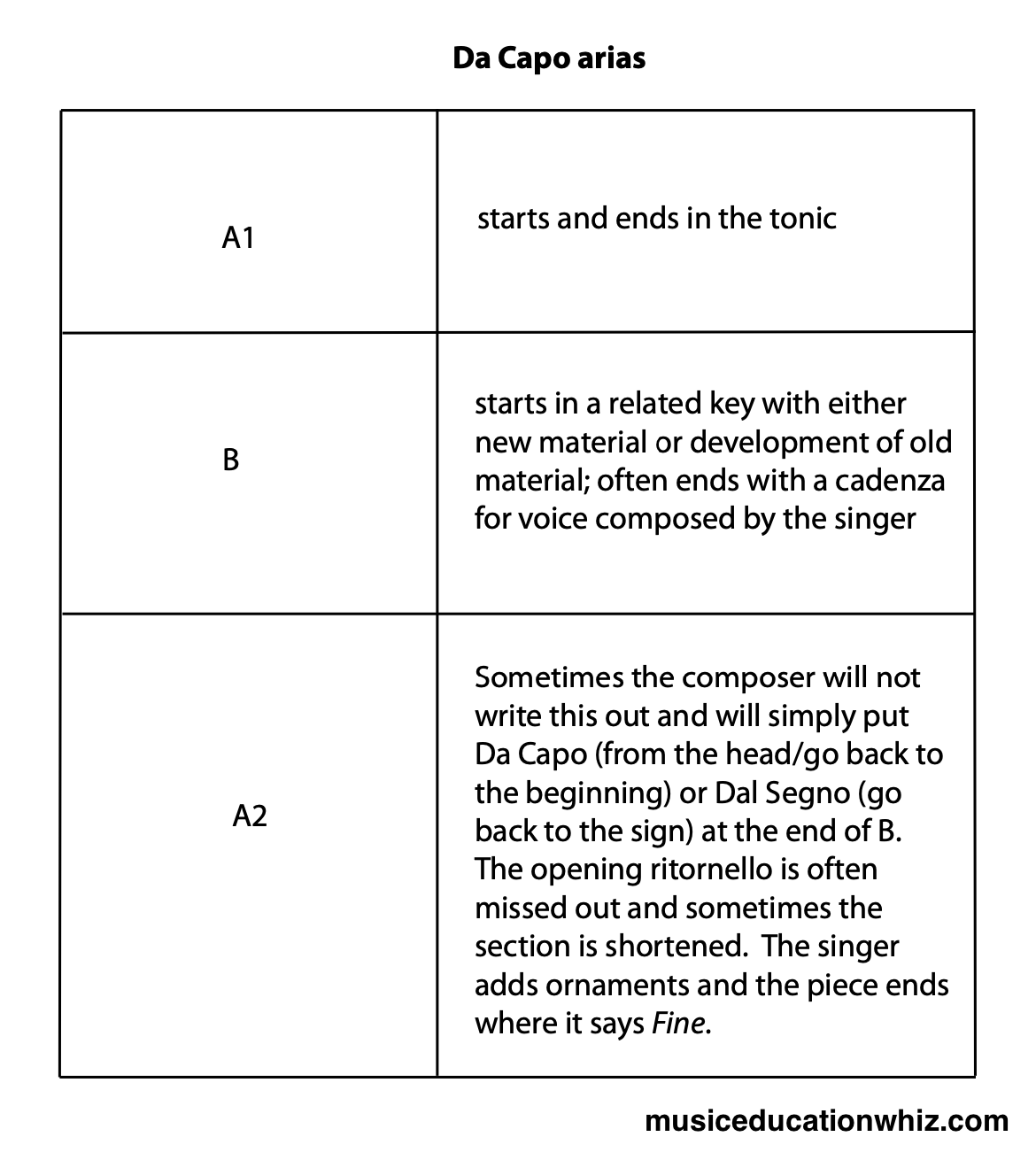
Powerpoint presentation of Handel's Piangerò la sorte mia from Giulio Cesare:
Watch the video below to see this structure in an analysis of 'Da Tempeste', Cleopatra's aria from Handel's Giulio Cesare:
Download the pdf of the analysed score used in this video.
Rondo Form
ABACADA
A returning theme is interspersed with ‘episodes’.
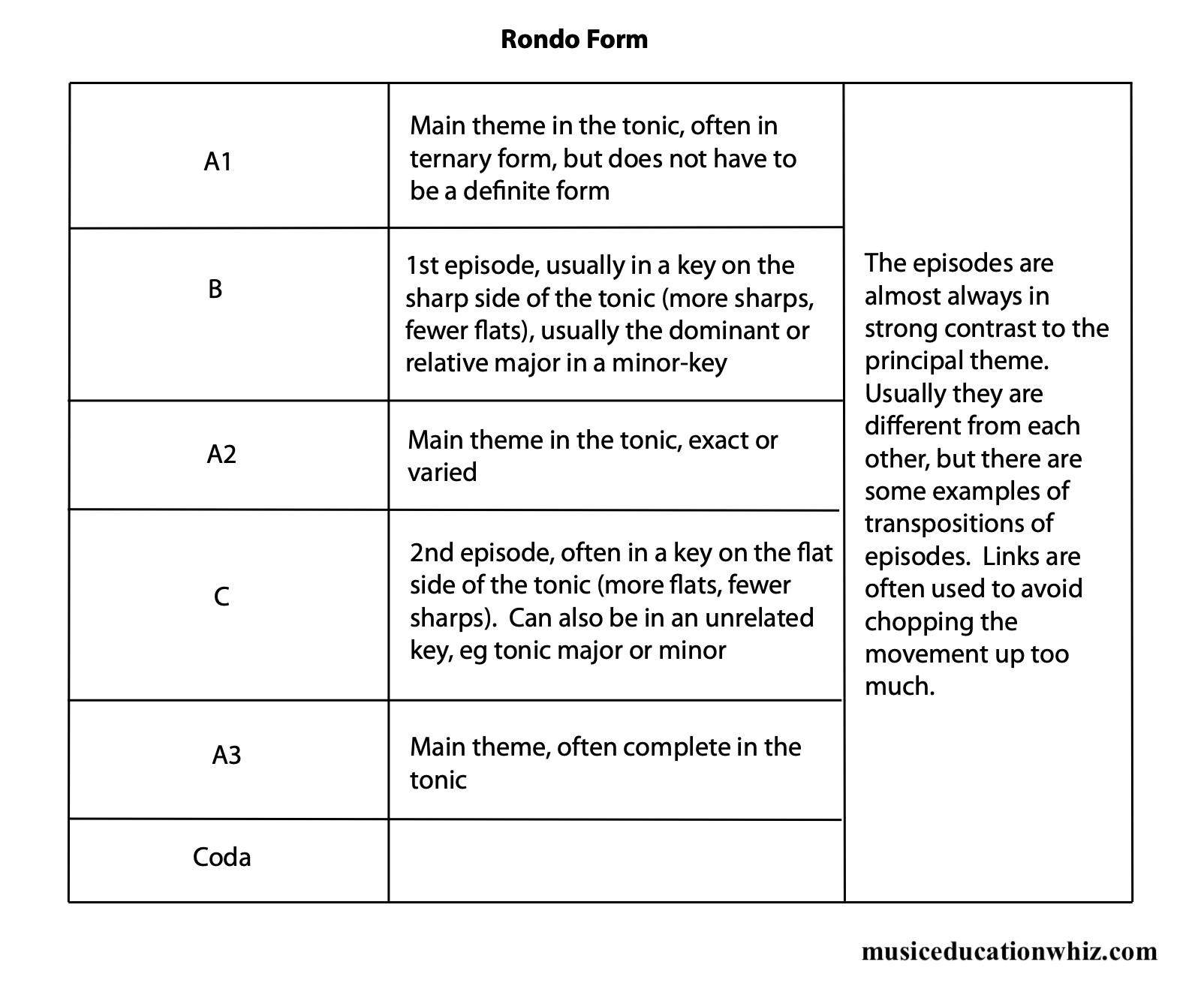
Watch the video below to see this structure in an analysis of the Romanze from Mozart's Eine Kleine Nachtmusik:
Download the pdf of the analysed score used in this video.
Ritornello Form
Similar to Rondo form, the principal theme or 'ritornello' returns throughout the piece, separated by episodes. In this way it forms the structural pillars of the movement. The episodes in ritornello form, however, are often based on material from the ritornello theme, and the ritornello theme appears in different keys throughout, usually in this order: tonic; dominant; relative major/minor; subdominant; tonic.
This form was used for first and last movements of Baroque Concertos. The full orchestra would play the ritornello theme and the soloist would play the episodes.
The video example is of the first movement of Bach's Violin Concerto in E Major, which is also in Ternary Form.
Download the pdf of the analysed score used in this video.
Sonata Form
Sonata Form developed from binary form.
Some people believe it derives from ternary form since there are three
sections: Exposition, Development,
Recapitulation. But it is clearly related to Rounded Binary Form, since the Development section is not a contrasting episode, rather it is based on the material from the Exposition.
Watch the video below to see an analysis of this structure in the first movement of Mozart's Eine Kleine Nachtmusik:
Download the pdf of the analysed score used in this video.
Beethoven expanded and developed sonata
form in the following ways:
* The Coda became an important section in
itself, whereas previously it had just been a reinforcement of the tonic with
several perfect cadences.
* He moved away from the rigid demarcation of
the various sections of a movement, achieving greater continuity and fluidity.
Sonata Rondo Form
This is a combination of Sonata and Rondo Form.
The First Subject is more melodic in this form than in Sonata Form.
Watch the video below to see this structure in an analysis of the last movement of Mozart's Piano Sonata III K.281:
Download the pdf of the analysed score used in this video.
Fugue
A fugue is a contrapuntal composition based around one theme, the Subject.
Before we show the form, it is necessary to define a few terms:
The Subject is a single melody which is capable of being treated and developed in a variety of ways.
The Answer is the subject transposed into the Dominant. If it is an exact transposition, the Answer is 'real'. Otherwise it is 'tonal'. 'Tonal' answers occur if the Subject modulates to the Dominant because the Answer must modulate back to the Tonic. 'Tonal' answers also occur is there is a tonic or dominant (or both) note early on in the subject. The tonic note in this case must be answered by the dominant note and the dominant note must be answered by the tonic in order to keep the Tonic key strong in our minds.
The Countersubject is the melody the first voice goes onto sing against the Answer when it has finished the Subject. If the Countersubject is used consistently against each entry of the Subject and Answer, it is called 'Regular'. If not, it is 'not regular'. It will need to be modified if the answer is 'tonal'.
A Codetta, which is usually based on material already introduced, is a linking passage and is used to avoid predictability.
Invertible Counterpoint is achieved when the Subject, Answer and either of the Countersubjects can go in the bass, therefore inverting the parts. Careful planning is necessary to avoid unprepared 6/4 chords.
The following fugal devices may appear in the Middle and Final sections:
Stretto: when entries of the Subject and Answer overlap, getting closer together
Augmentation of the Subject: the Subject is in longer note lengths, usually double
Diminution of the Subject: the subject is in shorter note lengths
Inverse movement: intervals in the Subject go up instead of down and vice versa
Pedal: long held note in the bass, usually dominant or tonic notes (an inverted Pedal is a long held note in a part other than the bass)
Watch the video below to see an analysis of Bach's Fugue in C Minor from 48 Preludes and Fugues, Book 1:
Download the pdf of the analysed score used in this video.
Theme and Variations
The first Variations on a theme were composed in the 16th century. Byrd wrote many. They tended to be a series of varied harmonisations of the tune and variations of figures in the added parts. Themes for Variations are usually in binary or ternary form. Themes can be varied melodically or harmonically. Melodic Variation means that the harmony is kept intact while either the melody is embellished or new figuration is applied to the harmony. Later, composers based variations on the principle of the development of motifs. This is called ‘development variation’.
Watch the video below to see an analysis of Mozart's variations on 'Ah! que vous dirais-je maman':
Download the pdf of the analysed score used in this video.
Ground Bass
A Ground Bass is a repeating bassline over which there are Variations. Purcell was the master of this form and wrote many arias in this form for his operas and masques. The example in the video below is Purcell's 'Music for a While' from Oedipus. The ground bass disappears for a while in the middle of the aria, and returns with the opening vocal theme to finish the piece. This is obviously similar to the Da Capo Aria.
Download the pdf of the analysed score used in this video.
Return to the top of the page
Home>Music Theory>Structure

Music Education
Resources by Paula Downes, a lot of music by Andrew Downes
Back to andrewdownes.com
Follow Cynthia Downes on Instagram to keep up-to-date with her blog posts.
If you have performed in any of Andrew Downes' works or come to listen, please share your experiences in the Premieres Blog! Also see what others have said. Thank you so much for your contribution.

